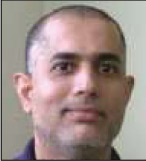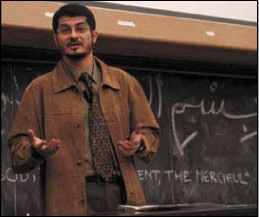Education Called Key
to Safe Hajj
By Betty Wells Miller
 Shakeel Syed
Shakeel Syed |
Inland Muslims on Thursday
called for better education for pilgrims participating in
the Hajj after 345 people were trampled to death near Mecca.
Leaders of the Shura Council of Southern California also
asked Saudi Arabian consular officials in Los Angeles for
a meeting to discuss orientation and safety measures that
would better protect the more than 2 million Muslims who
make the annual pilgrimage to the Middle Eastern kingdom.
"There is no excuse for this to happen, period,"
said Shakeel Syed, executive director of the Shura Council.
"We do not question their (Saudi officials') sincerity
of serving pilgrims. We do question the resources allocated,"
such as whether crowd monitors are adequately trained to
understand the diversity of cultures and languages or the
zeal of some pilgrims.
The Shura Council, an organization of mosques and Islamic
centers, called the Saudi Consulate on Thursday morning
after receiving numerous calls from Southern California
Muslims angry that at least 345 Muslims died and 289 were
injured in a stampede during the ritual stoning of a symbolic
devil.
"We asked for a meeting to help them understand it
is not rocket science in the 21st century to manage 2 million
people in two weeks," Syed said.
Inland Residents at Hajj
Dozens of Inland residents are in Saudi Arabia for Hajj,
the pilgrimage to Islam's holiest places that is required
once in the lifetime of every Muslim who is physically and
financially able.
The annual pilgrimage is a time of spiritual reflection
and unity with Muslims from diverse cultures, races, nationalities
and economic strata. It draws followers of Islam from tiny
villages in Bangladesh and Ukraine to wealthy Arab nations
and the United States, Inland Muslims said.
"The challenge is you have very poor peasants and farmers
from undeveloped countries for whom this is lifetime experience
for which there are no words," Syed said. For some
it is an intense, emotional experience, he said. "They
have been saving money their entire lives. They're now in
their 50s and 60s. They think fervor will get maximum reward."
 Hussam Ayloush
Hussam Ayloush |
A 1990 stampede during the
stone-throwing ritual killed 1,426 pilgrims, the Associated
Press reported. Another 244 died in February 2004 During
the ritual, Muslims walk on a two-level pedestrian bridge
the width of a freeway past three pillars symbolizing the
devil's attempts to persuade Abraham not to sacrifice the
son Muslims identify as Ishmael. Pilgrims toss pebbles at
the pillars in a ritual they believe earns forgiveness for
past sins.
Ritual Misunderstood Some Muslims incorrectly believe they
must visit al-Jamarat -- the three pillars -- between noon
and sundown and that their pebbles must strike the pillars
to satisfy the ritual. They do not, he said.
"The point is condemnation of evil," said Mustafa
Kuko, director of the Islamic Center of Riverside. "Some
people, if they miss, try to do it again and again."
Some also ignore designated exits and go against the crowd
to leave through the entrance, he said.
Hussam Ayloush, a Corona resident who participated in the
Hajj in 2000, said anyone who applies for a visa to the
hajj should also be required to attend an orientation so
they know what to expect.
Some Saudi crowd managers underestimate the religious zeal
of some pilgrims, Syed said.
"Some people get too hung up on the ritualistic process
to the point where they need to perform the ritual at all
costs, even if they push people around," said Ayloush,
executive director of the Southern California chapter of
the Council on American-Islamic Relations. He participated
in the Hajj in 2000. "Most Muslims behave well during
Hajj. It is a religious requirement to be nice. A Muslim
would lose the full reward of Hajj if they were to get angry
and push people around."
The Saudi government has spent millions of dollars to improve
sanitation and crowd movement in Mina, near Mecca, Inland
residents said. It also has considered scheduling specific
times for different encampments to visit the pillars to
regulate crowd movement, said Kalim Farooki, a Corona Muslim
who is facilitator of the Shura Council. He made the pilgrimage
in 1981.
"That's not easy to implement, because people are coming
from all around the world who are very emotional,"
he said. "There needs to be more supervising and education."
News reports say the stampede occurred when some pilgrims
tripped over luggage and were trampled.
"I attribute (the stampede) to the ignorance of some
Muslims how to do Hajj," said Kuko, who has made the
pilgrimage more than a dozen times. "Many come from
places where they don't get good education."
Orientation Program
The Riverside Islamic center conducted a Hajj orientation
for about 30 members in December, Kuko said.
Saudi crowd monitors also need training in how to communicate
with people from diverse cultures and languages, Syed said.
"They throw up their arms also in frustration,"
he said of crowd-control officials. "It's all happening
with good intentions. ... It's all happening because of
lack of education.”
(Courtesy The Press-Enterprise)
-------------------------------------------------------------------------------------

